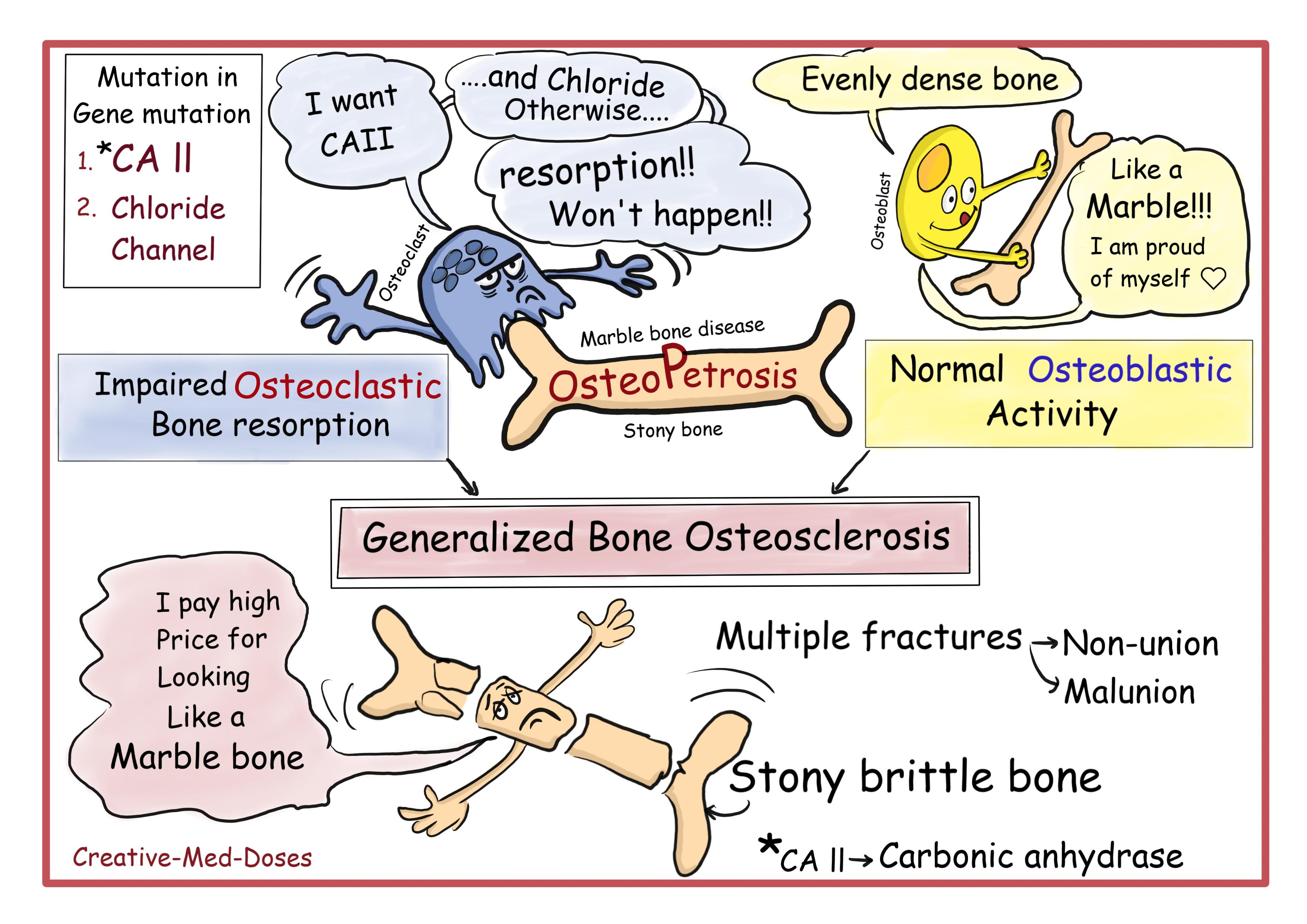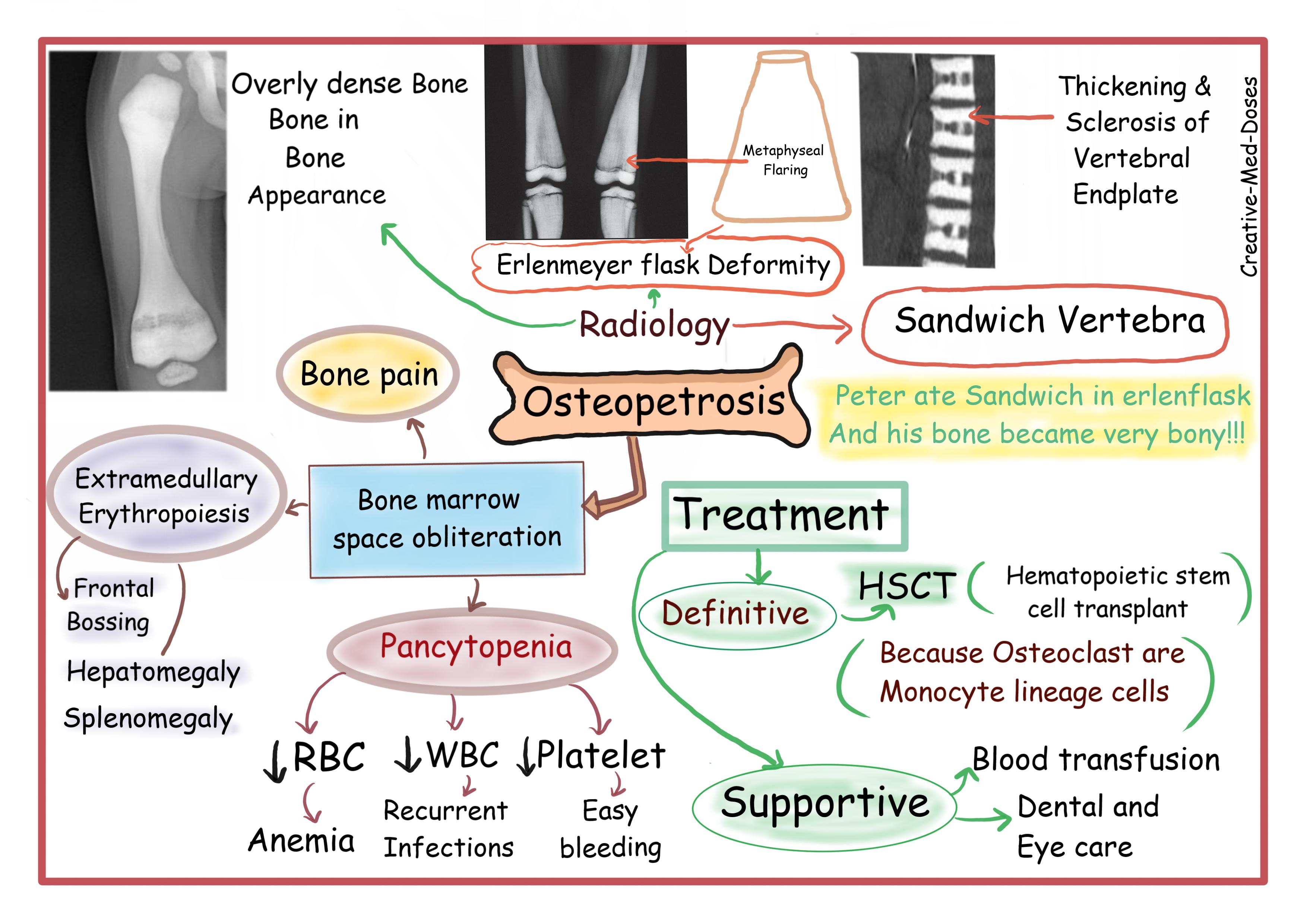Osteopetrosis cartoons and illustrations
Osteopetrosis cartoons and illustrations in this article will help you remember and revise more efficiently. I hope you like and share them, in covid19 Era I am trying very best to create these mind maps because this is best, I can do, other than practicing social distancing and whatever protocols are being suggested. Hope you stay safe and sane 🥰🥰 to practice medicine like a pro.
Overview
Osteopetrosis is also known as “Marble bone disease”. The other names are “Brittle bone disease” and “Albers-Schonberg disease. The term osteopetrosis is derived from Greek word “Osteon” meaning bone and “Petros” meaning stone, osteopetrosis literally means stony bone.
The disease has characteristic thickening of cortical bones with generalized bone sclerosis, the increased bone mass obliterates bone marrow space and causes hematopoietic insufficiency. It may also cause cranial nerve palsies, nerve entrapment syndromes and disturbed tooth eruption.
Osteopetrosis is inherited metabolic bone disease caused by defect in osteoclast associated bone resorption which causes defective bone remodeling and resultant bones are fragile despite increased bone density hence the name “Brittle bone disease”.
Etiology
Normal bone remodeling cycle has dynamic balance between bone resorption and bone formation. Osteoblast synthesize bone matrix and osteoclast mediate bone resorption.
In osteopetrosis osteoclast are unable to acidify bone matrix. Impairment in bone matrix acidification can happen because of proton pump defect, chloride channel or carbonic anhydrase dysfunction. Acidic micro-environment is very important for bone resorption by osteoclast.
Impaired bone resorption leads to overly dense bone that is more likely to fracture.
...

...
Clinical Types and Prognosis
There are three distinctive types of osteopetrosis
- Malignant
Autosomal recessive
Fatal in infancy
Proton pump or chloride channel dysfunction
- Intermediate
Autosomal recessive
Fatal in infancy
Carbonic anhydrase deficiency or chloride channel dysfunction
- Benign
Autosomal dominant
Chloride channel dysfunction
Normal life span with otherwise good health
The primary defect in all types of osteopetrosis is lack of acidic microenvironment which results in Impaired bone resorption.
Presentation
Autosomal recessive forms (malignant and intermediate)
- Nasal stuffiness due to paranasal sinus malformation (lack of pneumatization)
- Cranial nerve palsy manifesting as deafness, proptosis and hydrocephalus. Cranial nerve entrapment occurs because of overgrown skull bone narrowing the foramina.
- Bones are fragile and patient often presents with history of multiple fractures and malunion/ nonunion.
- Poor dentition and mandibular osteomyelitis.
- Defective osteous tissue obliterates bone marrow space resulting into bone marrow failure.
- Bone marrow failure leads to pancytopenia which manifests as anemia, recurrent infection and easy bleeding and bruising.
- Compensatory extramedullary erythropoiesis leads to hepatosplenomegaly, hypersplenism, hemolysis, frontal bossing and hair-on-end appearance. Macrocephaly and calvarial thickening are also present.
...

...
Adult osteopetrosis (Benign)
- Usually asymptomatic, and often diagnosis is made incidentally.
- Most common age of diagnosis is late adolescence or adulthood.
- Multiple fractures, osteomyelitis and early osteoarthritis is seen, patient also complains of bone pain especially lower back pain.
- Cranial nerve palsy is common
Imaging
Radiology has diagnostic importance in Osteopetrosis.
Bone has generalized osteosclerosis, overall bone density is increased (Bone within Bone appearance).
Skull is thickened (Calvarial thickening), hair-on-end appearance and frontal bossing is present. Sinuses are small and underpneumatized.
Sandwich vertebra and Erlenmeyer flask deformity (metaphyseal flaring) is seen.
Treatment
Bone marrow transplantation- it is the only cure for osteopetrosis.
High dose vitamin D (calcitriol)- It stimulates dormant osteoclasts and increases bone resorption.
Gamma Interferon- improves WBC function and reduces recurrent infections.
Erythropoietin and Blood transfusion – For anemia.
Fracture and nerve entrapment management.
...

...
Case scenario
- A 12-month-old boy presents to pediatrician with multiple long bone fractures and nasal stuffiness. The boy has history of recurrent pneumonia. On examination pallor, stunted growth and splenomegaly was noticed. His mother noticed easy bruising and recurrent nasal bleeding. X ray shows typically dense bones and malformed sinuses. What is most likely diagnosis??
- A 20-year-old man presented for assessment of right hip pain and chronic back pain with episodic increase when he goes to gym. He reported multiple fractures in past and prolonged healing time. X ray of pelvis demonstrated femoral metaphyseal widening and generalized increase in bone density. Radiograph of spine showed “Sandwich vertebra”. On examination hepatosplenomegaly was noticed, his lab tests show low hemoglobin, low WBC count, low platelet count with increased reticulocyte count.
Further reading https://rarediseases.org/rare-diseases/osteopetrosis/
Revision for today https://creativemeddoses.com/topics-list/diverticular-disease-of-intestine/
Buy books here 👇👇
Buy fun review books here (these are kindle eBook’s you can download kindle on any digital device and login with Amazon accounts to read them). Have fun and please leave review.